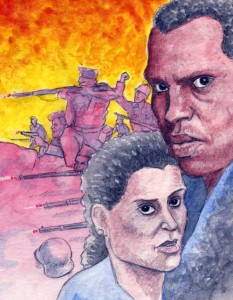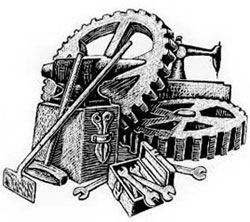Confessions of a Graphic Historian
 I said I wasn’t going to write about Abraham Lincoln any more, but here I am again—although this time his name refers to the American volunteers who fought in Spain from 1936 to 1939: the Abraham Lincoln Brigade. And, since many of my posts on this blog have examined recent graphic histories (what we used to call comic books), this time I thought I’d turn my critical eye inward.
I said I wasn’t going to write about Abraham Lincoln any more, but here I am again—although this time his name refers to the American volunteers who fought in Spain from 1936 to 1939: the Abraham Lincoln Brigade. And, since many of my posts on this blog have examined recent graphic histories (what we used to call comic books), this time I thought I’d turn my critical eye inward.
Last week I put the finishing touches on a comic book about Paul Robeson‘s January 1938 tour of Spain in support of the Republican government, which was under attack by a military uprising supported and armed by fascist Germany and Italy. Robeson in Spain will be published later this spring by the Abraham Lincoln Brigade Archives (ALBA) with support from The Puffin Foundation Ltd., the Bay Area Paul Robeson Centennial Committee, and private contributions. I drew the comic and co-wrote it with Peter Carroll, author among many other works of the authoritative study of the American volunteers, The Odyssey of the Abraham Lincoln Brigade: Americans in the Spanish Civil War (1994) and—full disclosure—Chair of the ALBA Board of Governors, of which I am a member. The story has been running in installments for the last year and a half in The Volunteer, the journal of the Veterans of the Abraham Lincoln Brigade (also available online).
Robeson’s trip, in the company of his wife Eslanda, proved crucial to the development of his political beliefs; he was deeply influenced by the struggle of the Spanish nationalists and, particularly, the prominent role of African Americans among the Americans (many of whom were members of the U.S. Communist Party) who volunteered to fight in support of the Republican cause. Robeson’s journey and the unique situation of the black volunteers, who for the first time fought in integrated U.S. units and in some cases under the command of black officers, is a story that we believe is especially useful to teach the interwar years in middle- and high-school U.S. and world history courses. The comic’s graphic narrative is, therefore, supplemented by some contextual information as well as additional online documents and resources that will be posted on the ALBA website (which, by the way, already has excellent online multimedia lessons on a number of related topics).
As in any project on which one labors for some time, I’ve grown acutely aware of its strengths and weaknesses—and in this case, abetted by prior experience, the decisions and compromises one faces in writing and visualizing a nonfiction graphic narrative are still fresh in my mind. So, before I forget them, I thought I’d jot down a few impressions about the process of doing this type of historical work.
Approaching the subject, Peter and I faced the usual narrative decisions and compromises—although the comic form involves that intriguing challenge of a narrative trajectory and dramatic pacing that are shaped as much by the gaps between panels as in the panels themselves (envision waves and troughs of ellipses and details). Added to that, we chose to make our story relatively short in length (all of 21 pages) to accommodate use in the classroom, so events were severely telescoped, their essence reduced, or if you will refined, to curt narration, brief interchanges, expressive gestures, telling expressions—at their best the information and meaning conveyed via a balance between text and image. These issues are typical when constructing a graphic narrative, and should be almost second nature if you’ve delved in the form for any length of time.
Unlike other graphic projects I’ve worked on, my knowledge of Paul Robeson, the Spanish Civil War, and the Abraham Lincoln Brigade was limited, in stark contrast to the depth and breadth of Peter’s. I believe that gap worked well in our collaboration: we would play out together the contents and trajectory of each narrative installment and then figure out ways to convey the drama and meaning via concision, pacing, and visual cues. Early on, I think we made an important decision in terms of the story’s informational and dramatic emphasis by moving the attention midway through the installments from the Robesons to focus on several of the African-American volunteers they encountered. In effect, Robeson’s discovery of the black volunteers, which affected him greatly, became the means by which we could expand the story to encompass a broader social and political history of race and racism in the United States—while never leaving the immediate context of the Spanish Civil War.
Visualizing the history turned out to be more of a challenge than I’d anticipated. The problem with comics is that, even for expressionistic works such as Marjane Satrapi’s Persepolis, some sense of place must be conveyed. In Robeson in Spain we opted for a more “documented†look, in part to keep the reader/viewer aware of the story’s time and place. In case you didn’t know, all pictorial reference materials are not online—and getting hold of photographs dating back to the 1930s of some of the places the Robesons visited turned out to be impossible. To be honest, some of my renderings of localities were projections backward in time, or composites of similar localities or situations (unfortunately, there were all too many photographs available of the aftermath of fascist aerial bombings). Such semi-educated visual guesses also applied to some of the characters whose visual documentation was at best limited to one or two murky photographs.
Paul Robeson, himself, posed a challenge. Drawing him consistently, let alone well, was one issue, of course (and I remain dissatisfied by certain panels). But the very public nature of the man posed another sort of obstacle for us: trying to grasp the private man was difficult and, consequently, getting across the impact of his Spanish experiences was doubly difficult, especially in the explicit format of a comic. To fill the gap between the public and private man, we chose silence: there are sequences where we show Robeson thinking, pondering, troubled—but not speaking. Time is one feature that the sequential nature of comics can convey well, and I hope in those sequences, however briefly, we show a man going through changes that we actually can’t see.
The proof of the efficacy of all this, of course, is in the comic book itself, responses to which we await with bated breath!
Last 5 posts by Josh Brown
- The Civil War Draft Riots at 150 – A Public Event - June 17th, 2013
- Alfred F. Young - November 7th, 2012


